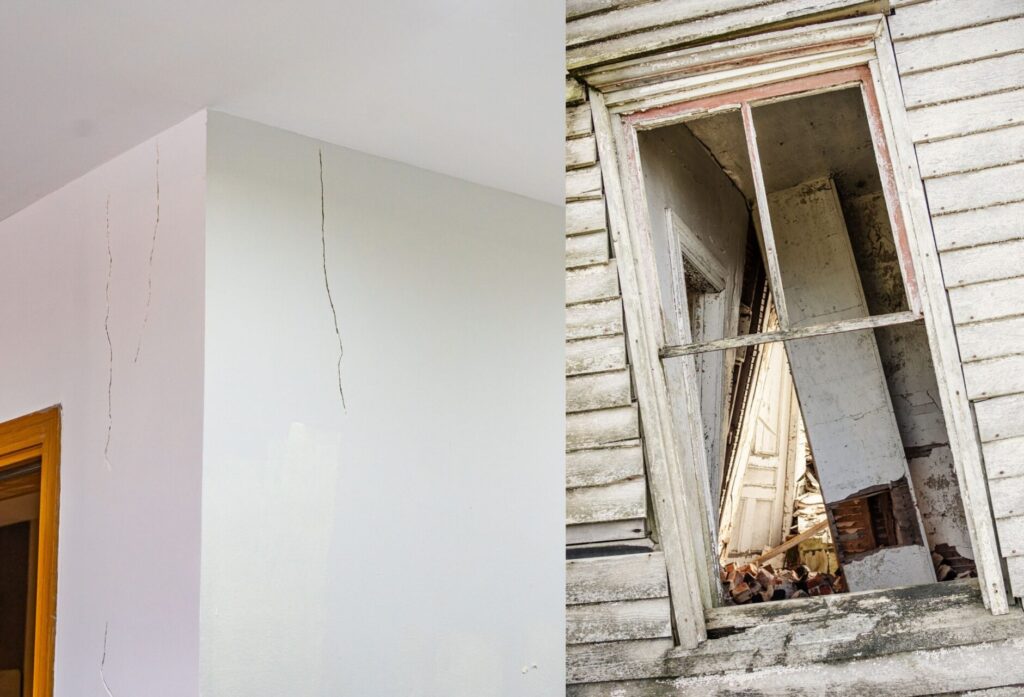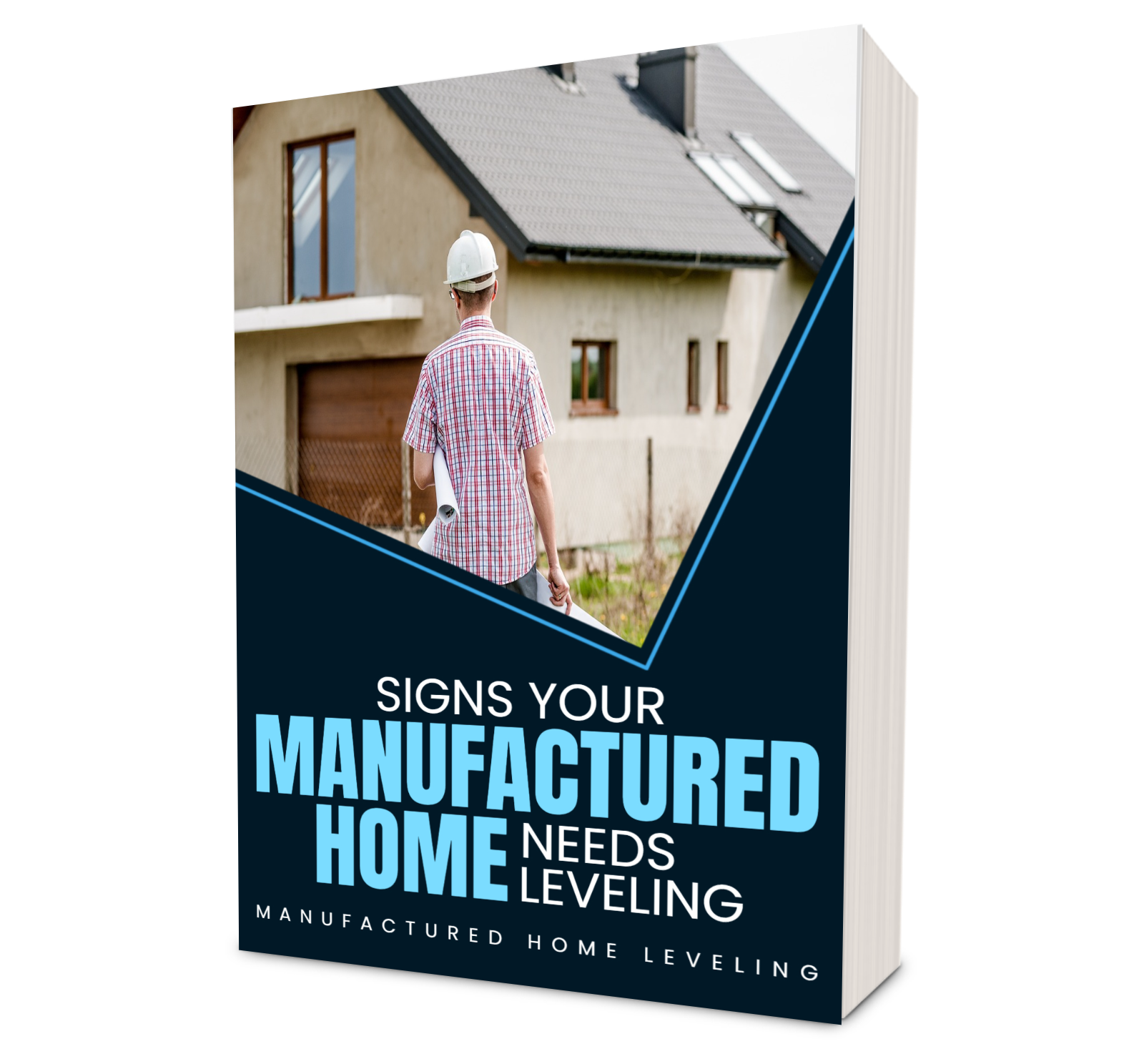A Comprehensive Guide to Mobile Home Releveling
This post contains affiliate links. We may earn a commission when you purchase products mentioned in this post. View our full affiliate disclosure here.
Is Your Mobile Home Feeling a Little Uneven?
If you’ve noticed your floors feeling unlevel, doors sticking, or cracks appearing in your walls, it’s a good sign that your mobile home might need releveling. Don’t worry, though – it’s a fairly common problem with relatively simple solutions.
In this comprehensive guide, we’ll explore everything you need to know about mobile home releveling, from identifying the telltale signs to understanding the releveling process, and even diving into the costs involved. By the end, you’ll be equipped with the knowledge to make informed decisions about restoring your home’s foundation and ensuring its long-term stability.
The Art of Releveling Your Rolling Roost
Picture this: you’re sipping coffee in your cozy mobile home, sunlight streaming through the windows. Suddenly, your mug tips precariously, coffee threatening to paint the floor like a brown Jackson Pollock. You glance around, noticing doors that wouldn’t close if you tried with all you might, and cracks snaking across the walls like tiny fault lines. Yikes! It seems your once-steady haven has developed a case of the wobbles. Fear not, fellow mobile home dweller, for this is where the magic of releveling comes in.
Imagine, if you will, your home transformed from a teetering tilt-a-whirl to a sturdy sanctuary. Floors become level playing fields for marbles and toddlers alike. Doors glide shut with the satisfying whisper of a well-oiled secret. Walls stand tall, unblemished by the worry lines of unevenness. This, my friends, is the power of releveling – a process as crucial as it is fascinating.
In this article, we’ll embark on a journey to the heart of mobile home stability. We’ll unearth the telltale signs that your home needs a lift (pun intended!), explore the various methods used by releveling wizards, and even peek behind the curtain of costs involved. By the time we’re through, you’ll be able to navigate the world of releveling like a seasoned pro, ready to restore your home to its rightful state of serene equilibrium.
So, grab your metaphorical toolbox of curiosity and let’s get started! Buckle up, because we’re about to take your mobile home from wonky to wow-worthy, one perfectly leveled corner at a time.
Signs Your Mobile Home Needs Releveling
Living in a mobile home should be a symphony of serenity, not a cacophony of creaks and groans. But sometimes, the gentle swaying that characterizes these rolling abodes can morph into a disconcerting tilt, turning your haven into a funhouse of uneven floors and wonky doors. If you suspect your once-steady haven has developed a case of the leans, fear not! Unmasking the signs of a need for releveling is the first step on the path to restoring harmony to your home.
So, how do you know if your mobile home is whispering, “It’s time for a lift!”? Keep your eyes peeled for these telltale clues:
The Floor Detectives:

- Marble Mayhem: Once bouncy balls and toy cars followed predictable paths, but now they seem to roll downhill with a life of their own? Uneven floors are the prime suspects.
- Uneven Footing: Does walking through your home feel like navigating a terrain map? Stumbles and tripped toes might be due to a sloping floor.
- Furniture Frustration: If your furniture seems to shift or doesn’t sit flat, your foundation may have shifted.
The Door Detectives:
- Sticking Doors: Doors that once glided open now require force to move are often a red flag.
- Window Wobble: Windows that won’t open or close properly could be due to uneven settling.
The Wall Whisperers:

- Crack in Walls: Cracks in walls are often signs of stress from foundation imbalances.
- Uneven Edges: Gaps or misaligned trim can indicate that your home’s foundation is settling unevenly.
- Bonus Clue: The Sound of Silence: Creaking floors and groaning walls could be your home’s way of pleading for a releveling intervention.
From Wonky to Wow, One Jack at a Time
Once you’ve identified the signs of unevenness, the next step is understanding the releveling process. This process is where the real magic happens, transforming wobbly floors into sturdy surfaces and sticky doors into smoothly operating portals.
The Releveling Methods:
- Hydraulic Jacks: These powerful tools lift your home one corner at a time, allowing precise adjustments to the foundation.
- Shims: Thin pieces of wood or metal are inserted between the beams and support piers, ensuring even support.
- Tie-Downs: Steel anchors secure your home to the ground, preventing future tilts and wobbles.
The choice of method depends on the severity of the tilt and your home’s foundation type. Professional releveling experts will assess the situation and choose the appropriate tools and techniques to restore your home’s equilibrium.
The Releveling Process: A Step-by-Step Guide
We’ve identified the uneven evil plaguing your mobile haven, and even peeked at the superhero tools used to vanquish it. Now, the time has come to dive headfirst into the actual releveling process, a fascinating dance between precision and brute force. Think of it as a backstage tour of how these modern-day Atlases keep your rolling world from going off-kilter.
The releveling journey typically unfolds in four acts:
Act I: The Assessment
Before any work begins, professionals will conduct a thorough assessment using laser levels and other tools to map out the extent of the tilt. This step is crucial in determining the best approach.
Act II: Lifting the Home
Using hydraulic jacks, the home is carefully lifted one corner at a time. This step provides access to the foundation for necessary adjustments.
Act III: Shimming
Shims are inserted to fill gaps between support beams and piers, ensuring the home rests evenly. This process is key to achieving a perfectly level home.
Act IV: Securing the Home
Finally, steel tie-downs are installed to anchor the home securely to the ground, preventing future shifts.
The specific process may vary depending on your home’s foundation type and the severity of the unevenness, but these steps provide a general overview.
Budgeting for Your Mobile Home Releveling
Ah, the age-old question that haunts every superhero movie and, in this case, every mobile homeowner facing the uneven beast: how much will it cost to vanquish the tilt and restore level living to my rolling haven? Fear not, brave adventurer, for the cost of your releveling revolution, while not fixed, can be estimated with the right intel.
Think of it like assembling your superhero team – each member (tool, technique) comes with a price tag, and the final budget depends on the villain you’re facing (severity of unevenness) and the size of your home (number of piers, foundation type). But fret not, with a bit of detective work, you can get a good idea of the investment needed to reclaim your level kingdom.
The Villain’s Price Tag:
- Minor Tilt: For a slight tilt, a simple releveling using jacks and shims might cost around $450 to $600. Think of it as a quick “shim and go” operation.
- Moderate Tilt: If the unevenness is more pronounced, expect to pay $750 to $900 for a more involved releveling process, likely including foundation adjustments and additional materials. Picture this as a “shim and stay” scenario.
- Major Tilt: For significant foundation issues or extensive releveling needs, the cost can climb to $1,500 or more. This is akin to a full-blown “shim and conquer” mission.
Foundation Factor: Remember, the foundation type plays a role too. Concrete slab foundations might require specialized techniques like mudjacking, adding to the overall cost.
Home Size: Naturally, a larger mobile home will have more support piers to adjust, meaning more labor and materials, and therefore, a higher price tag.
Additional Costs: Don’t forget to factor in additional costs like permits, disposal fees for old materials, and travel charges for the releveling crew.
Mysteries of Mobile Home Releveling
So, you’ve embarked on the quest for a level mobile home, armed with knowledge about methods, costs, and finding the right releveling crew. But even the bravest heroes have lingering questions before facing the final boss – in this case, the uneven foundation. Fear not, brave adventurer, for this chapter is dedicated to unraveling the most frequently asked questions (FAQs) about mobile home releveling, ensuring you face the tilt with confidence.
Leveling Mysteries Answered:
- When do I know it’s time to relevel?
Aside from the telltale signs like uneven floors, sticking doors, and cracks in walls, pay attention to unusual sounds: creaking floors, groaning walls, or persistent popping of windows. These can also be indicators of needing releveling.
- How long does the releveling process take?
Simple releveling for minor tilts can be done in a day, while more complex jobs with foundation adjustments might take 2-3 days. Remember, patience is a superhero’s virtue – so is scheduling the releveling when you can be away from home for those days.
- Can I relevel my mobile home myself?
While DIY is tempting, releveling requires expertise and specialized tools. Improper leveling can worsen problems and even compromise your home’s safety. Leave it to the professional releveling wizards – their magic is worth the investment.
- Will releveling damage my home?
Reputable releveling professionals take precautions to minimize any disruption. However, expect minor cosmetic touch-ups like caulking gaps around the skirting might be needed after the process.
- Will releveling increase the value of my mobile home?
Absolutely! A level and stable home is more appealing to potential buyers, potentially even increasing its market value. Think of it as an investment in both your immediate comfort and future resale potential.
- What happens if I don’t address the unevenness?
Ignoring the tilt can lead to more serious problems – structural damage, leaks, and even foundation failure. It’s like letting the villain grow stronger; the longer you wait, the harder and more expensive it will be to vanquish the unevenness.
- How can I prevent future releveling needs?
Proper maintenance plays a key role. Ensure adequate drainage around your home, avoid overloading it with furniture or appliances in one area, and regularly check for signs of unevenness. Think of it as preventative measures against the villain’s return.
Conquering Tilts and Claiming Your Mobile Home Haven
The journey’s end is near, fellow mobile home dweller! You’ve faced the uneven truth, unmasked the villainous tilt, and learned the secrets of the releveling wizards. Now, armed with knowledge and empowered by action, you stand at the threshold of a leveled life, where floors become dance floors, doors sing sweet symphonies of opening and closing, and walls stand tall, unblemished by the worry lines of unevenness.
Remember:
- A level home is a happy home.
- Releveling is an investment in your comfort, safety, and resale value.
- Don’t wait—address the tilt before it grows stronger.
- Choose reputable releveling professionals—their expertise is worth the investment.
- Enjoy the leveled life—it’s a symphony of peace and stability.
So, if the telltale whispers of unevenness dance through your home, fear not! Embrace the knowledge you’ve gleaned, let the releveling wizards work their magic, and step into a world where level living reigns supreme. Your rolling haven awaits, a sanctuary of serenity where every corner sings the harmonious tune of perfect balance.
And for those still seeking guidance, remember, resources abound! Ask friends, family, or neighbors for recommendations, utilize online reviews, and compare quotes from different companies. Knowledge is your shield, research your sword, and together, you will conquer the uneven beast and claim your rightful kingdom of level living.
Go forth, brave adventurer, and may your mobile home forever stand tall, a testament to your resilience and a beacon of harmony in a world that sometimes tilts. The leveled life awaits – claim it with confidence!
FAQs
How Much Does It Cost to Level a Mobile Home?
The cost to level a mobile home typically ranges between $450 and $1,500. For single-wide homes, you can expect to pay around $450 to $850, while double-wide homes usually cost between $800 and $1,500. Prices vary depending on factors such as the size of the home and the extent of leveling required. Given the complexity and precision needed for proper leveling, it is highly recommended to hire professional services to ensure the job is done correctly and safely. Professionals have the expertise and equipment necessary to handle the leveling process efficiently, providing peace of mind and preventing potential future issues.
The information provided in this blog post is for general informational purposes only. Mobile home leveling involves complex processes that should not be attempted as a DIY project. We strongly recommend seeking professional help to ensure safety and proper handling. Always consult with licensed professionals for any mobile home leveling or structural repairs. Your safety and the stability of your home are our top priorities.
- Mobile and Manufactured Home Foundation Types: What You Need to Know!
- Everything You Need to Know About Mobile Home Leveling Wedges: Installation & Tips
- How to Level Your Mobile Home with a Laser Level: Step-by-Step Expert Guide
- Mobile Home Skirting 101: What You Need to Know Before You Buy
- Window Screens for Mobile Homes: The Essential Guide You Can’t Afford to Skip
- Mobile Home vs Trailer Home? Discover the Key Differences and Make the Right Choice!
- Modular Home vs Manufactured Home: Uncover the Hidden Differences Before You Decide!
- Mobile Home vs Manufactured Home: Which One is Right for You?”
- Professional Mobile Home Leveling: What to Expect
- Mobile Home Water Level 101: What Every Owner Needs to Know


